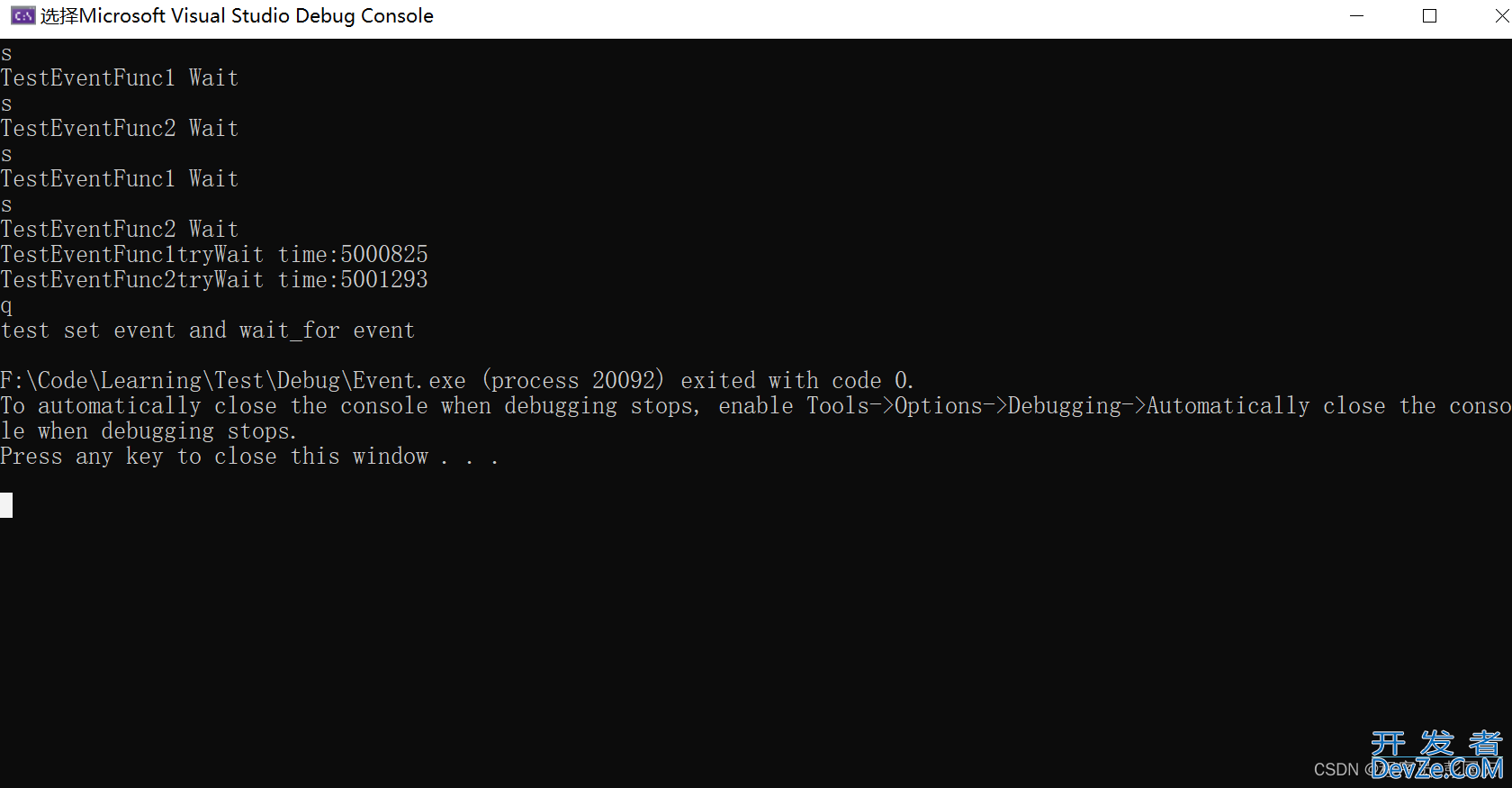C++实现一个简易版的事件(Event)的示例代码
目录
- 一、前言
- 二、实现
- 2.1 需要具备的功能
- 2.2 代码实现
- 三、测试
一、前言
利用 WaitForSingleObject 检查内核对象的状态来进行实现。后来随着需要开发跨平台的程序后这种方式就不能使用了, 毕竟这是 Windows 专属。 POCO 库在 windows之外的系统选择利用 pthread 线程库库来实现 Event, pthread 毕竟不在C++标准库里面,假设要使用的话需要单独配置。所以本文就利用 C++11之后的标准库内容来实现一个事件类, 方便使用。
本文代码地址:https://github.com/pengguoqing/samples_code
二、实现
2.1 需要具备的功能
①支持多线程
②可以等待一定时间
2.2 代码实现
一共提供四个对外接口, 分别如下:
//设置事件有信号
inline void SetEvent() const;
//重置事件为无信号
inline void ResetEvent() const;
//持续等待直到事件有信号, 如果是 Auto 模式则必须等待到该线程能拿到状态
inline void Wait() const;
//等待事件一定时间, 时间范围内事件有信号则返回 true,否则返回 false
template <typename Rep, typename Period>
inline bool tryWait(const std::chrono::duration<Rep, Period>& duratio) const;
类内部再对具体的实现进行一下封装
struct EventImpl
{
explicit EventImpl(Mode mode, bool initState);
~EventImpl() = default;
inline void Set();
inline void Reset();
inline void Wait();
template <typename Rep, typename Period>
inline bool Wait_for(const std::chrono::duration<Rep, Period>& duration);
std::mutex m_mutex;
std::condition_variable m_condi;
bool m_signal;
const Mode m_mode;
};
使用 unique_ptr 对 EventImpl 资源进行管理:
const std::shared_ptr<EventImpl> m_event;
因为没有裸露的指针资源,移动和拷贝函数就直接全部使用编译器默认的
explicit CXEvent(Mode mode = Mopythonde::Auto, bool initstate = false); ~CXEvent() = default;
三、测试
测试用一个事件实例来实现两个线程的同步测试, 键盘输入字符 ‘s’ 触发一次事件, 每个线程 Wait() 两次事件后,再测试一下 tryWait() 时间。代码如下:
using namespace std;
static CXEvent kEvent;
static constexpr int testCnt = 3;
TestEventFunc1(const CXEvent& refEvent)
{
for (int i=0; i< testCnt; i++)
{
if (i == testCnt-1)
{
auto begin = chrono::high_resolution_clock::now();
kEvent.tryWait(5000ms);
auto end = chrono::high_resolution_clock::now();
auto duration = chrono::duration_cast<chrono::microseconds>(end - begin);
cout << "TestEventFunc1"<<"tryWait time:"<< duration.count() << endl;
}
else
{
kEvent.Wait();
cout << "TestEventFunc1 Wait" << endl;
}
}
}
TestEventFunc2(const CXEvent& refEvent)
{
for (int i=0; i<testCnt; i++)
{
if (i == testCnt-1)
{
auto begin = chrono::high_resolution_clock::now();
kEvent.tryWait(5000ms);
auto end = chrono::high_resolution_clock::now();
auto duration = chrono::duration_cast<chrono::microseconds>(end - begin);
cout << "TestEventFunc2" << "tryWait time:"<< duration.count()<< endl;
}
else
{
kEvent.Wait();
cout << "TestEventFunc2 Wait" << endl;
}
}
}
int main()
{
CXEvent refEvent1(kEvent);
CXEvent refEvent2(kEvent);
std::thread testTh1(TestEventFunc1, refEvent1);
std::thread testTh2(TestEventFunc2, refEvent2);
int cinCnt{0};
char inputCmd {'R'};
cin.get(inputCmd);
while ('q'!=inputCmd && cinCnt<testCnt*2)
{
if ('s' == inputCmd)
{
kEvent.SetEvent();
cinCnt++;
}
cin.get(inputCmd);
}
if (testTh1.joinable())
{
testTh1.join();
}
if (testTh2.joinable())
{
testTh2.join();
}
std::cout << "test set event and wait开发者_C学习_for event\n";
}
期php望结果是每输入一次 ‘s’ 回车后,TestEventFunc1或者TestEventFunc2线程函数中的循环体就会被执行一次,每个循环体执行两次后等待 5 秒线程就退出,再输入‘q’ python退出程序。实际运行结果如下:

符合预期。
到此这篇关于C++实现一js个简易版的事件(Event)的示例代码的文章就介绍到这了,更多相编程关C++事件内容请搜索我们以前的文章或继续浏览下面的相关文章希望大家以后多多支持我们!





 加载中,请稍侯......
加载中,请稍侯......
精彩评论